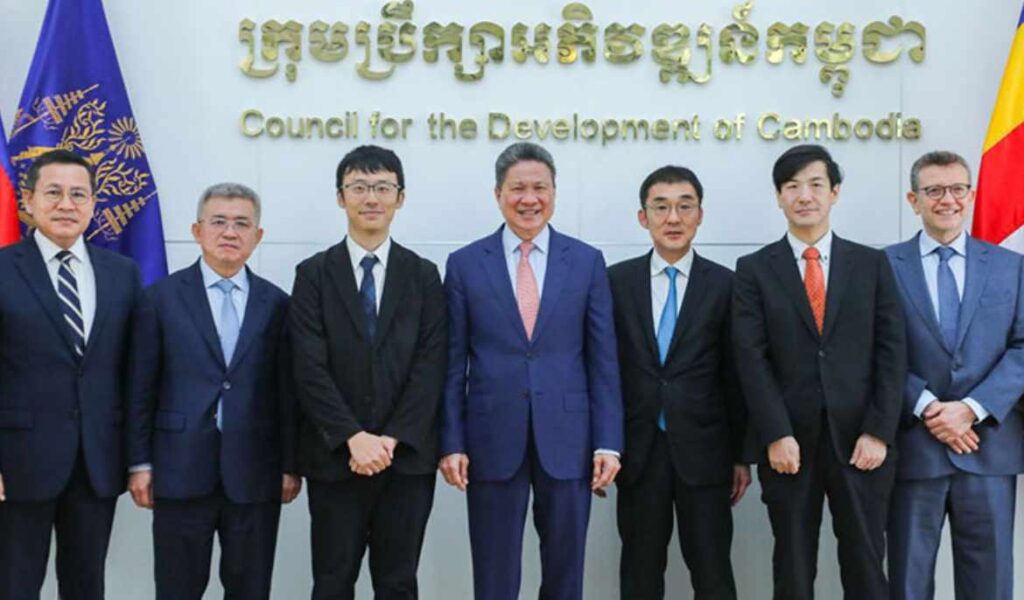The Council for the Development of Cambodia (CDC) Wednesday extended its support to the ‘Cambodia-Japan Joint Economic Cooperation’ project for the sustainable expansion of Japanese businesses in Cambodia.
The initiative was reinforced during a meeting between Sun Chanthol, Deputy Prime Minister and First Vice Chairman of the CDC, and a Japanese delegation led by Watanabe Tetsuya, President of the Economic Research Institute for ASEAN and East Asia (ERIA).
Fujioka Ryosuke, Advisor to Japan’s Minister of Economy, Trade, and Industry (METI) and Secretary-General of the AEM-METI Economic and Industrial Cooperation Committee (AMEICC) and other representatives were also present on the occasion.
The meeting focused on reviewing two significant research projects including the ‘Cambodia-Japan Economic Cooperation through sustainable expansion of Japanese business in Cambodia,’ conducted by METI, and ‘Special Economic Zone and Green Industrial Park Policy for Productivity Growth and Economic Diversification in Cambodia,’ by ERIA.
These projects aim to enhance investment opportunities, strengthen trade ties, and promote sustainable economic development in Cambodia.
A key outcome of the discussion was the announcement that the final report of the METI research project will be presented at the upcoming Cambodia-Japan Public-Private Dialogue Forum. This forum will serve as a platform for further collaboration between the two countries, reinforcing their shared commitment to economic growth and industrial development.
With these efforts, Cambodia continues to position itself as a favourable destination for Japanese investment, paving the way for long-term economic cooperation and mutual prosperity.
Speaking to Khmer Times, Seun Sam, a policy analyst at the Royal Academy of Cambodia, emphasized that foreign investors, particularly Japanese companies, conduct extensive research before committing to investments in any country.
“They examine various factors, including political stability, production capacity, and the quality of infrastructure such as water supply, electricity, and transportation networks. Most importantly, they assess issues like corruption, extraneous costs, and regulatory transparency before making investment decisions,” Sam explained.
He further noted that attracting Japanese and other foreign investors requires Cambodia to address its internal challenges and enhance its institutional capacity. “Investors are not opposed to Cambodia as a destination, but before making any commitment, they always hire professional market assessment teams to conduct detailed studies. These assessments evaluate investment opportunities, potential risks, and projected profitability,” he added.
According to Sam, foreign investors operate with a strong focus on financial returns and risk management. “If their market research determines that a particular venture is unlikely to be profitable, they simply will not invest. All investment groups prioritize financial sustainability, and they will not allocate resources to markets with significant uncertainties or inefficiencies,” he said.
Sam stressed that if the Cambodian government is serious about attracting foreign investment, it must take concrete steps to address existing shortcomings. “Improving governance, reducing bureaucratic red tape, and tackling corruption are critical factors in building investor confidence. Additionally, strengthening infrastructure and enhancing the tourism sector will further contribute to making Cambodia a more attractive investment destination,” he said.
Japan is currently Cambodia’s fifth-largest trading partner, with bilateral trade (exports and imports combined) reaching $2.16 billion from January to December 2024, a 20.1 percent year-on-year increase.
Cambodia’s exports to Japan totaled $1.4 billion in 2024, marking a 19.8 percent increase compared to the previous year. Meanwhile, Cambodia’s imports from Japan reached $752.56 million, an increase of 20.7 percent.



